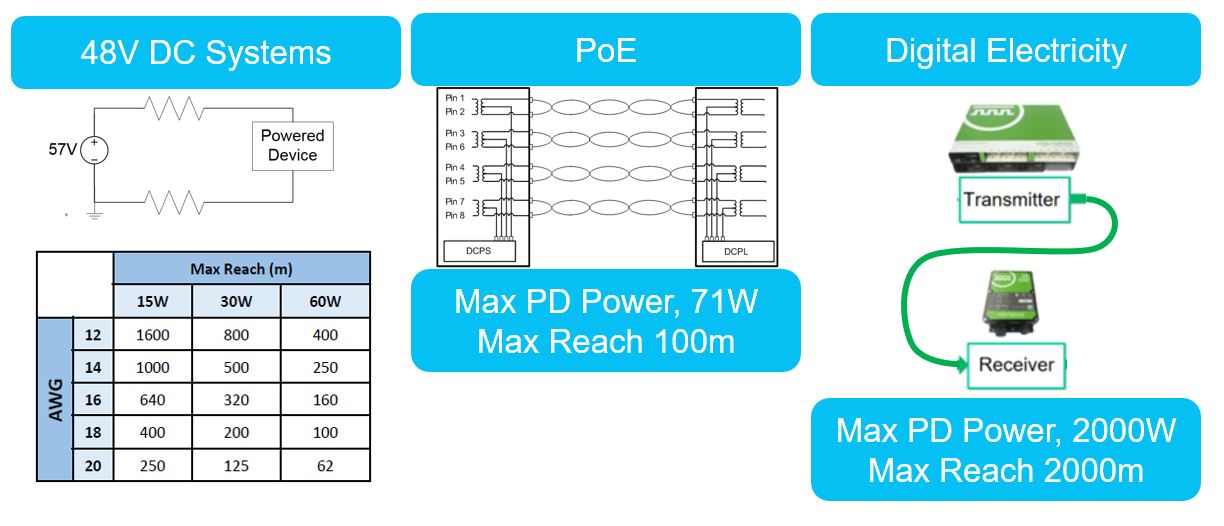Digital Electricity™: 5 Dinge, die Sie wissen müssen
There’s talk of a new way to safely distribute high-voltage power over long distances (and it’s not Power over Ethernet, or PoE). It’s called “Digital Electricity™,” (VoltServer, Digital Electricity™, and the circle logo are trademarks of VoltServer Inc.) and it’s having an impact on the way power is distributed across buildings, campuses and cities.
Digital Electricity™ combines data and DC power into packets that are transmitted and received similarly to how data packets travel over enterprise networks. It transfers high levels of power over non-power cable. A complete system requires transmitters and receivers.
The transmitter (which looks like a server) takes in AC or DC power and sends it out on individual electrical circuits (like a breaker panel). From there, specialized Digital Electricity™ cable (somewhat similar to security or control cable) can be used to distribute the power. The receiver "receives" the electricity packets sent from a transmitter and converts the energy packets into the required form (i.e. 57V DC, or 120V rms).
Whereas PoE technology can carry up to 100W of power over a data cable for up to 100 m, Digital Electricity™ can carry up to 2,000W or travel up to 2,000 m. In simple terms, Digital Electricity™ offers 20 times the power or 20 times the distance that’s currently available through PoE. That’s enough power to support an entire building’s wireless system, including DAS, ONTs, PoE switches, IoT devices, etc.

Here’s what you need to know about Digital Electricity™ …
1. It Ensures Safety
As long as electricity stays within its designated circuit and power flows along the correct path, it doesn't cause problems or injury. When power is allowed to leave its designated circuit (exposed wires, loose connections, etc.), that's when it becomes dangerous.
The concept of Digital Electricity™ includes a “smart circuit” that can tell when the flow of electricity is escaping – and then stop it immediately. This protects against high current levels, ground fault, arc fault and touching hazards.
After each energy packet is sent, the transmitter de-energizes the circuit to the receiver. It quickly checks to make sure electricity made it to the receiver (600 times per second). If it did, the process continues. If it didn't, the process stops within 3 milliseconds. This is fast enough to prevent injury or danger.
2. It Allows for Ample Power
As installed racks in data centers start to need more power to support emerging technologies and applications, a cable carrying Digital Electricity™ can be run through an existing cable tray to double or triple the amount of power brought to the equipment.
3. It Provides a Back-Up
To provide back-up power in an emergency, the transmitter can run critical power to every office location within a building. This can provide power to wireless systems so employees can continue operations even when the power to the building isn't available.
4. It Simplifies Cable Installation
Because of how energy is handled in these systems, installation of cables carrying Digital Electricity™ doesn’t require an electrician. Low-voltage installers and systems integrators can complete the install. This makes installation faster and more cost effective. You won’t require conduit or as much copper, and technician labor will be more affordable.
Digital Electricity™ cables are also easy to relocate and reuse, without leaving stranded outlets or conduit behind – and without requiring help from an electrician to make it happen.
5. It Enables New Applications
This technology allows power to be taken much longer distances with lower voltage drops - and without dealing with large copper wires. When the environment doesn't easily support traditional cable lengths - like in an airport, sports stadium or transportation center - Digital Electricity™ can be used.
It powers systems like:
- Media converters
- Mobile radios (DAS/small cell/macro)
- ONTs
- PoE switches
- Routers and servers
- Smart displays and digital signage
- Smart LEDs
- Wireless Access Points
As the ability to carry power safely over long distances becomes more important, we think Digital Electricity™ will continue to increase in use. Have questions about Digital Electricity™, or want to learn if it might work in your application?
